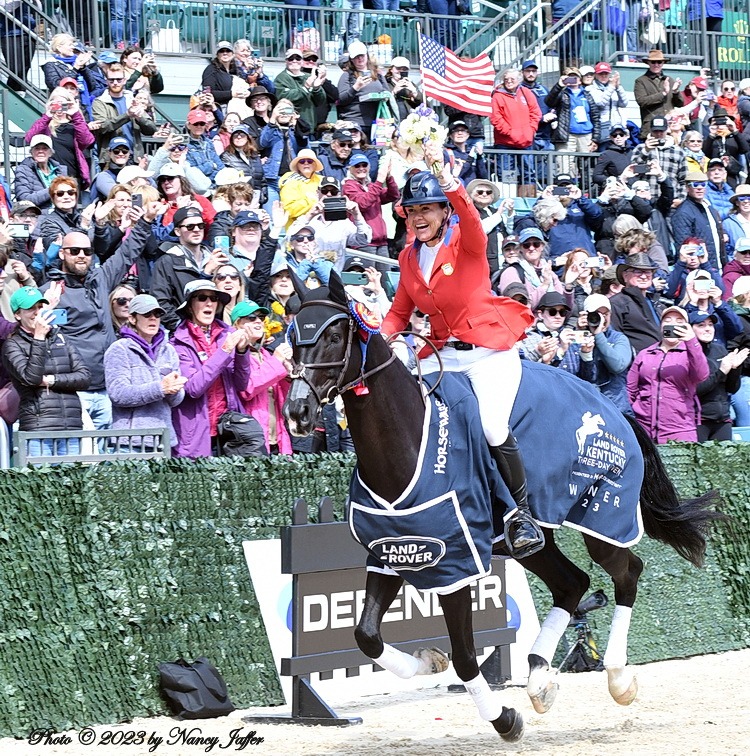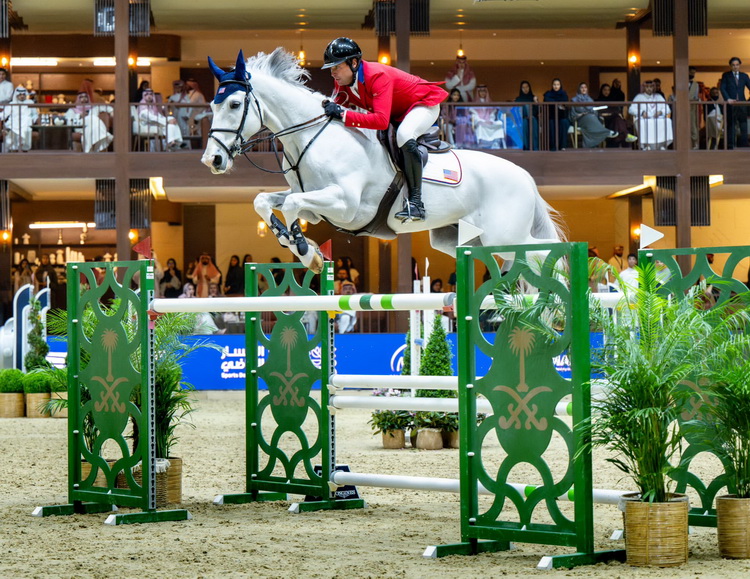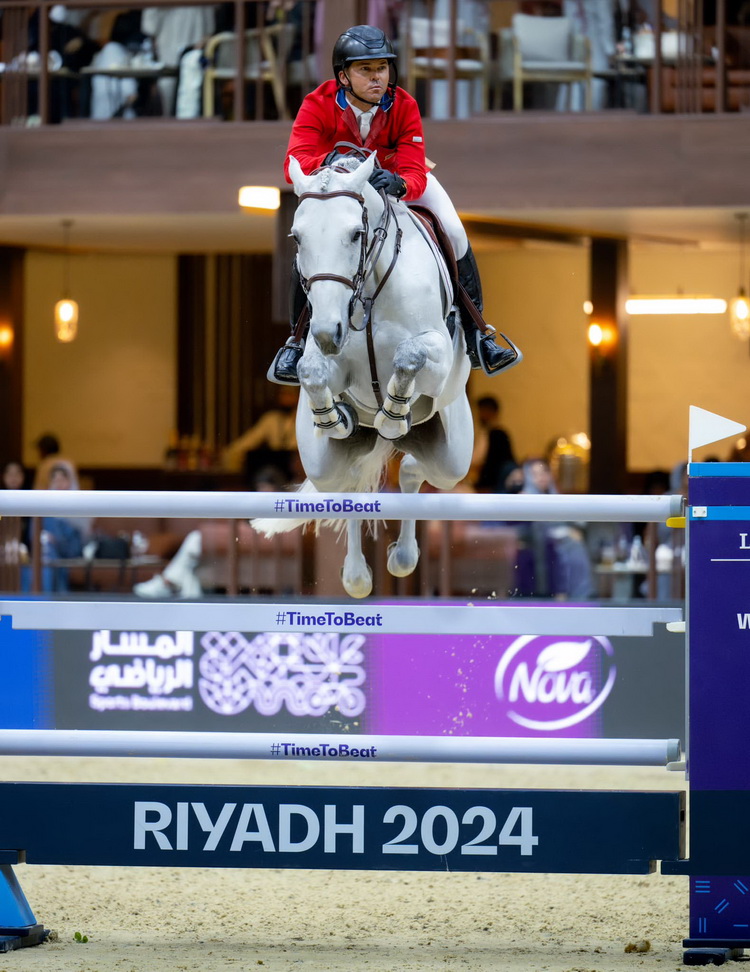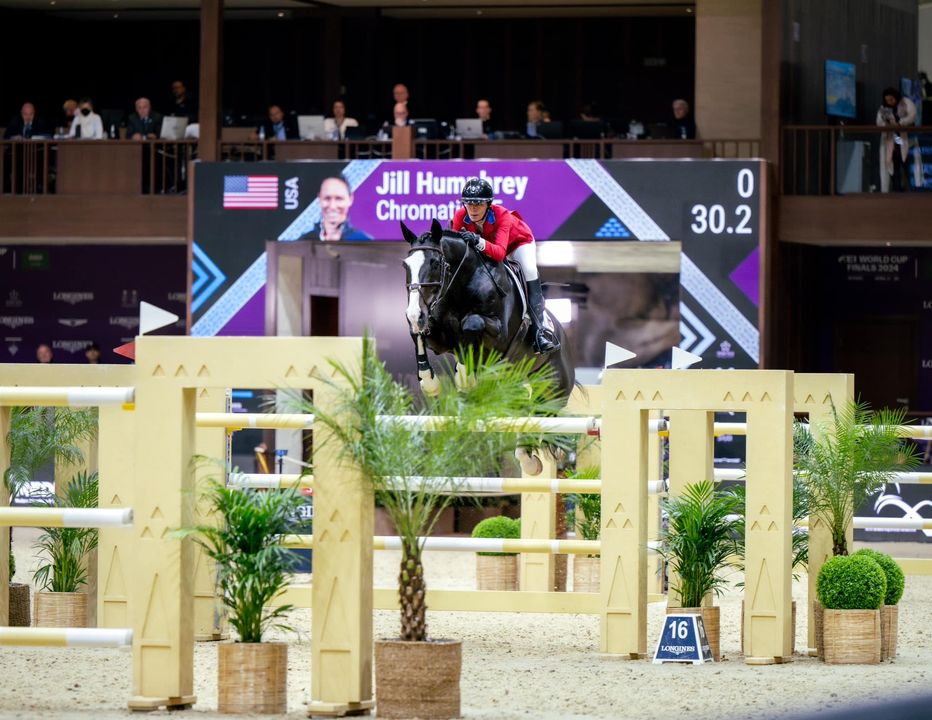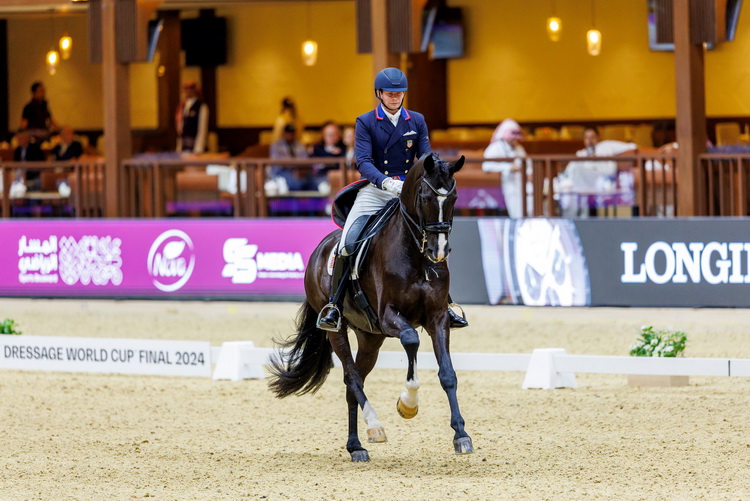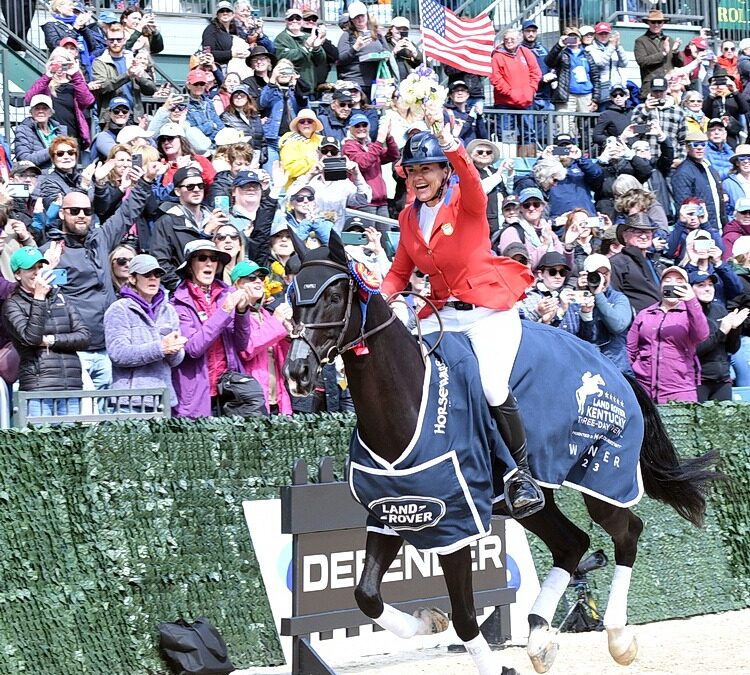

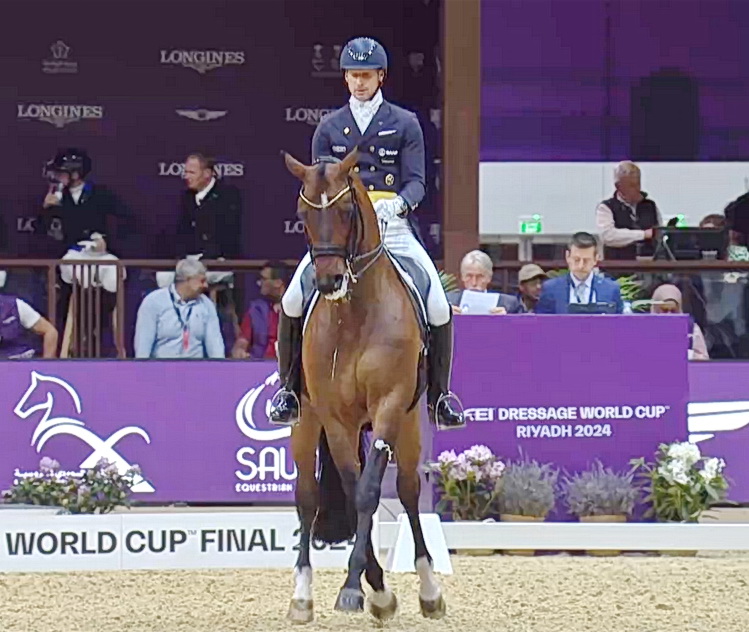
Sweden on top at World Cup again, this time in dressage: UPDATED
Sweden, which is dominating the Longines Show Jumping World Cup Finals, got a winner in the co-featured dressage competition today, as Patrik Kittel took the prize on Touchdown during his ninth career start in the indoor championship.
The show in Riyadh, Saudi Arabia, marred by the death of a show jumper on Thursday night (read about it here), had another mishap this afternoon; upsetting, though certainly far less serious. World Champion Lottie Fry of Great Britain, who won the Grand Prix on Wednesday, was not able to compete after her horse, Everdale, showed blood in his mouth before he started his performance.
The FEI stated: A minor bleed originating from the front gum mucosa was found in the mouth of the horse by the Judge at C, and in accordance with Article 430.7.6 of the FEI Dressage Rules, this results in elimination.
Elimination under this rule does not imply there was any wrongdoing but the rules are in place to protect the welfare of all competing horses.
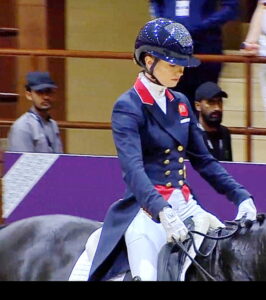
A downcast Lottie Fry leaves the arena after Everdale was eliminated.
Van Olst Horses, for whom Lottie rides, commented: “We are of course upset with the elimination, but the horse’s welfare always comes first and foremost so completely respect the decision. Everdale was checked over by the FEI vet team straight away and they couldn’t find any sign of a cut or abrasion in the mouth and our own vet has also given him a thorough check with no obvious cause.
“The most important thing is he’s fine and there is no injury. We were really happy with the warm up where he was relaxed, we took his bandages off and gave him a final check before heading in to the arena and can only think he maybe just caught his front lip as we went around the arena. It’s a disappointing way to end our FEI World Cup campaign but we have a happy horse to take home for another day.”
The freestyle had loads of atmosphere, with spectators — many in traditional Saudi dress — enjoying the music and cheering for each competitor.
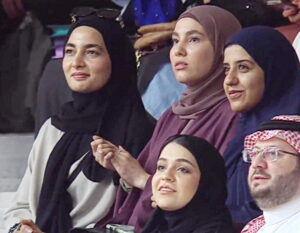
Saudi spectators watched the dressage intently.
The standard of performance was high, with everyone who made the podium marked at more than 81 percent in an incredibly close finish separated by fractions.
Patrik was in tears after his ride to James Bond movie theme music when he realized that he had won with a score of 81.661.
A close second was Denmark’s Nanna Skodborg Merrald (who also was second at last year’s finals in Omaha), with 81.429 percent on Blue Hors Don Olymbrio. Isabell Werth of Germany missed her sixth Cup victory, finishing third with DSP Quantaz (81.404)
An emotional Patrik said, “I cannot believe it. My horse was so amazing. Touchdown just flew with me. I was nervous. He felt amazing on the warmup and to go in there and perform like that. The crowd was unbelievable. Louise (Nathhorst) my trainer won it the first time for Sweden and now I won for Sweden again.
“I’m very overwhelmed. I’m not often overwhelmed but today I’m on another planet. The power and fighting spirit Touchdown shows me, it’s for me the biggest win. I cannot thank him enough.”
After her ride to the music of “Spiderman,” Nanna said, “It’s unbelievable finishing second one more year. I’m still almost shaking. He felt so great in there.
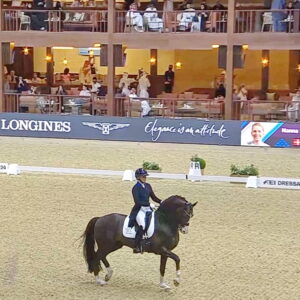
Nanna Skodborg Merrald and Blue Hors Don Olymbrio show their best in the atmospheric arena.
“I’m thrilled being able to be second between those two super riders. It was such a cool atmosphere in there today. I really liked riding my new music.”
Isabell originally was supposed to ride Emilio on his farewell tour before retirement, but he wasn’t sound enough to come so she brought Quantaz.
“It was very exciting,” she commented, noting there had never been such a narrow margin among the riders on the podium.
Quantaz faced a real challenge.
“Today it was very hard for him,” she said.
“When I came in, he was scared about the advertising, the screens. Also the people with the white clothes (men wearing the white flowing floor-length garment known as the thobe.)
“It was hard for him to concentrate. He was really with me and tried his best.It was a little bit busy with the atmosphere, but he really tried.”
You had to love her pirouettes appropriately timed to her music, which was “Turn Around.”
Although she has won the Finals five times, and participated on many more occasions, riding in them never gets boring for her.
“That’s what I love to do,” she said, citing. “so much energy and emotions. This is fun.”

Isabell Werth was pleased with her ride on DSP Quantaz.
Justina Vanagaite of Lithuania was eighth on Nabab with a score of 75.104. She was overcome with emotion after her ride, explaining she made the horse herself and she continues to be the one who does everything with the Belgian warmblood gelding. Unlike the people she was competing against, she doesn’t have a multi-person support staff.
“I’m the groom, I’m the trainer,” she said.

Justina Vanagaite and Nabab
Justina wore a blue and yellow ribbon showing her support for Ukraine. It has special meaning because Lithuania is one of the Baltic states that some believe are next on the Russian hit list.
The top finisher of the three American competitors was Anna Marek with Fayvel, ninth of 14 starters on 74.518 percent.
Though she won bronze individually at the Pan American Games last fall with another horse, this was Anna’s first Cup finals and she loved it.
“It’s so relaxing when you are able to concentrate on one horse and to be able to come to something like this, a World Cup, and not only have my horse perform for me, but the stars aligned and we had a ride like we did today It’s just the best feeling.”

Anna Marek and Faivel. (Direk Caremans photo)
When she started planning a freestyle with the hope of qualifying for the Final, she realized, “This horse is so handy. We can do some really tricky things. So we made something that almost every single part of the canter work has combinations linked together.”
The other U.S. riders, Ben Ebeling and Kevin Kohmann, finished 13th and 14th respectively.
Click here for results

No surprise–von Eckermann takes another World Cup Finals: UPDATED
Henrik von Eckermann of Sweden didn’t just win the Longines FEI World Cup Show Jumping Final this afternoon, he did it in a style worthy of his number one global ranking. The defending champion was fault-free in each segment of the competition in Riyadh, Saudi Arabia, until he was reunited with the special trophy he won last year.
The magnificent chestnut King Edward, who understands the game as well as his rider, made a supreme effort not to dislodge a rail — even when things looked iffy while he was in the air – as he carried out his role in a perfect partnership for success.
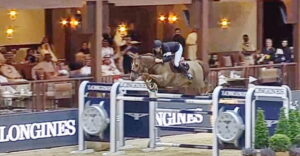
Henrik von Eckermann and King Edward.
It was the second championship for Sweden at the competition, with Patrik Kittel also scoring for his homeland in taking the Dressage World Cup on Friday.
Winning the way Henrik did took a toll, and he understandably was exhausted by the tremendous effort.
“I’m so tired. I’m so empty. It’s like someone pulls the plug out of you. It didn’t help that I fell off in the warm-up,” he noted. The mishap came when King Edward had an uncharacteristic refusal.
“It doesn’t help to get nervous or stressed, because the horse feels everything and King Edward is anyway a very, very sensitive horse, so for him when that happened, I just said, `Don’t worry, let’s stay calm and don’t let him feel that everything is a little not like it should be,’ ” he explained.
“I think I paid the price for my jump-off on Friday,” Henrik observed, saying maybe he “exaggerated a little bit” with the wild gallop he took to the final fence in that tie-breaker to insure victory.
“I was so fed up with being second from the other shows, I did three 5-stars and was second in every one” he explained, noting that was what happened when he played it safe.
But the key to victory at the first Final in the Middle East was the teamwork between horse and rider.
“It went well and we’ve been together so long and know each other so well that I had the biggest confidence in him, and that helped to have that feeling that, even with this mistake, what happened, happened. It was still zero on the scoreboard and that’s what counts! So I just focused on that,” Henrik said.
He joins a short list of back-to-back winners of the Cup, including Britain’s John Whitaker (Milton), Canada’s Ian Millar (Big Ben), Austria’s Hugo Simon (who won the first Cup final in 1979, then went on to do two in a row in 1996 and 1997), Rodrigo Pessoa of Brazil, who won three times in a row; Meredith Michaels Beerbaum of Germany, who won twice in a row in 2008 and 2009, after winning the first time in 2005 and Steve Guerdat of Switerland, who won back-to-back in 2015 and 2016, then won again in 2019.
The field that was lined up against him was filled with formidable names, including France’s Julien Epaillard, known for his ability to ride at speed He was just one rail behind the winner on the mare Dubai du Cedre, and would have been dangerous if it came down to a jump-off.
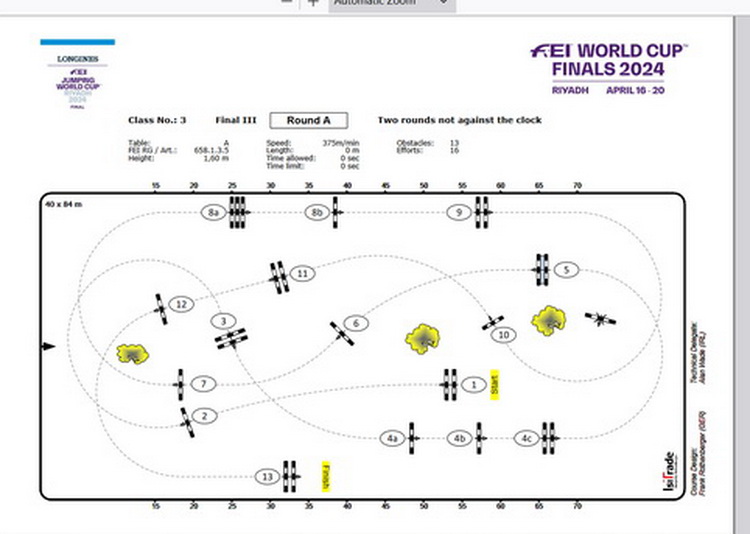
Round A course
Julien said the idea of coming to the World Cup was to “make another championship with her before the Olympics (in Paris this summer) to see what we have to work (on), what at the moment was not 100 percent. Today we have a top feeling and I think the mare and I have a nice program for the Olympics now.”

Julien Epaillard, Henrik von Eckermann and Peder Fredricson on the podium.
Henrik’s teammate, Peder Fredricksen on the 18-year-old Catch Me Not, was just two penalties back of Julien. The USA’s Kent Farrington barely missed the podium on his rising star Greya, only 10 years old and a mere four penalties behind Peder after having a rail in the second round.

Peder Fredricson and Catch Me Not, part of the Swedish power pack. (Photo © 2024 by Melanie Smith Taylor)
“That’s a very impressive finish,” U.S. chef d’equipe Robert Ridland observed, noting Kent has brought his mare along “really carefully.” Robert pointed out the finish really means something because, “The caliber of this competition is very impressive.”
Kent totally agreed.
“Obviously, coming here with my two lesser experienced horses (Toulayna went in the initial speed leg) I knew my chance at winning was going to need everything to go my way. They are short on experience, but havea lot of talent and finished fouorth behind the best horses in the world, I think, was a great finish and both horses will have learned a lot also,” he said.
The U.S. wound up with two riders in the top 20, as Devin Ryan finished seventeenth overall on veteran Eddie Blue, who was second in the 2018 World Cup finals.
“He and Eddie Blue got better every round,” Robert said, noting that if Devin hadn’t had three rails in the first leg on Wednesday “it would have made all the difference.”
Even so, he told me, “Devin had a solid World Cup final.

Saturday’s second course.
Devin, tied for tenth in the final day’s competition, was asked how he thought his horse did. The rider replied, “he felt amazing,” while noting the final round designed by Frank Rothenberger was really big.
He had a rail at the third-to-last jump, saying he believed, “I had enough rhythm, but I got a little close and he really got careful off the front pole and it was a bit of stretch the back pole, and we just tipped it down.”
When I asked Robert what the Cup showed us about the competition the U.S. will be facing in Paris this summer, he replied, “I try to pay no attention to our opponents because we have no control over that.”
Then he went on to say that “the French are strong, there’s no question. The Swedes obviously proved they are consistent and a threat, to say the least. They’ve been strong all the way back to the world championships in Tryon (2018) when we jumped off against them. They just missed winning the world championships by us beating them in the jump-off.
“Then the tables were turned three years later in Tokyo (the 2021 Olympics). And we all know the Irish are strong, too. They didn’t have their strongest riders here. We’ll have some competition, there’s no question about it. I think the level of the sport has never been higher.
“You saw all these top riders here, and there were still some missing.”
“With ours, it’s an Olympic year, so it’s not a priority for Laura (Kraut) or McLain (Ward) this close to the Olympics in Paris.”
The show jumping prize money of $2.89 million set a record for the World Cup, which has drawn raves for the way the event had been put on, and Robert was no exception in praising the Saudi effort.

Saudi spectators were very enthusiastic about the competition.
“It was a great World Cup Final from their side. They put a heck of a lot into it. Everything was top notch. No question about how they did it. Everybody friendly, warm-up area was magnificent, the main arena was magnificent; courses obviously, I thought Frank Rothenberger did a good job. The organizing committee went all out. Pretty impressive.”
It can’t go without mentioning the loss of the U.S. mount Chromatic BF after he jumped brilliantly on Thursday.
“It was incredibly sad,” said Robert, noting Jill Humphrey “rode a great round on the horse.” To learn more about what happened, click here.
Click here to see the results of the final competition
Click here to see the final standings
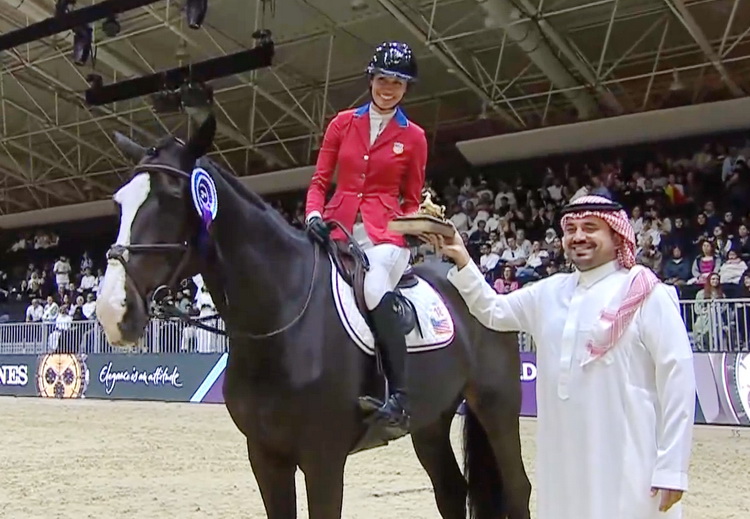
American horse dies after fabulous performance at show jumping World Cup Finals
Tragedy followed triumph tonight as Chromatic BF—who earlier had jumped to third place in the Longines FEI Show Jumping World Cup Finals—collapsed in his stall and died in Riyadh, Saudi Arabia. (Click here to read the competition story or go to the second story on this page.)
Ridden by Californian Jill Humphrey, the U.S.-bred Chromatic had shown no symptoms as he returned to the barn after the awards ceremony.
His owner/breeder, Kc Branscomb, explained on social media exactly what happened to the 13-year-old Oldenburg: “I am writing this to try to clarify what has already begun to travel as rumors surrounding events that happened here in Riyadh involving Chromatic after tonight’s spectacular performance. After hacking normally after the class, Chromatic returned to the barn happy and calm attended by his lifetime caretaker, Pepe Rodriguez, and Jill.
“After resting and refreshment, he was given a routine recovery shot of electrolytes by the U.S. team veterinarian. Upon returning to his stable to be wrapped, blanketed, and put away for the evening, with me (KC Branscomb) present, the horse…seizured and collapsed in the stall. He was immediately treated and examined by both the U.S. and FEI veterinarians and was pronounced dead shortly after. As owner and breeder, I want it clearly stated that no one was at fault. The horse did not suffer and there is no evidence that his passing was in any way related to his strenuous and spectacular performance with Jill well over an hour earlier, or the team veterinarian’s injection. A full autopsy report will be provided to me at some point.
“But what I HOPE people will take away from this freak accident and great tragedy is that it was a night of tears — tears of joy and tears of loss. If I would ask anything of those of you that knew or celebrated him, let’s remember him for how he lived and not for how he died. The sport lost a great one today.”
The FEI said samples were already taken from the horse and a full postmortem in line with FEI protocols will be conducted.
“The FEI, the organizing committee and the Saudi Arabian Equestrian Federation send their deepest condolences to the rider, owners, groom and connections.”
People were posting condolences on social media. One of them, John Charlebois, wrote: “He was an amazing horse with a gigantic fan club and a folk hero in the horse world. He was more than a Superstar.”
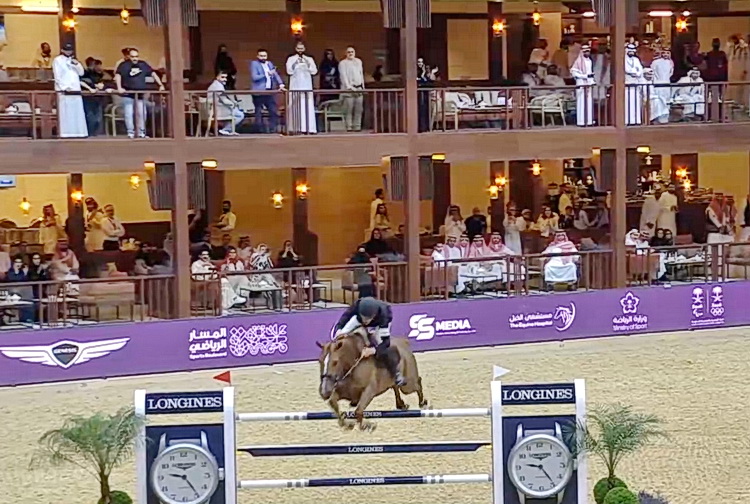
It’s Sweden/Sweden at the Show Jumping World Cup
It was a Swedish showdown for the top placings on the second day of the Longines FEI Show Jumping World Cup Finals, but an American who hadn’t ridden in the event for 17 years impressed by moving up the ranks to take third in Riyadh, Saudi Arabia.

Henrik von Eckermann and King Edward.
As expected, world number one Henrik von Eckermann of Sweden successfully continued to defend the title he won in Omaha last year with the fabulous King Edward, galloping hard to the final fence in a seven-horse jump-off to top the leaderboard once again. His longtime teammate, Peder Fredricson, was behind him today in the number two spot with Catch Me Not.
“For two really nice rounds, the horse jumped first jump to the last both rounds, couldn’t be better,” said Henrik.
“It was an amazing feeling. Of course, it was a little bit nervous, but I really enjoyed just riding in there. Peder keeps pressure on me,” he added good naturedly.

Henrik von Eckermann explains it all to Swedish chef d’equipe Henrik Ancarkcrona during the course walk.
Californian Jill Humphrey also wowed the crowd with her exacting trips aboard the U.S.-bred Chromatic BF. She moved up from 12th after Wednesday’s one-round speed opener after putting in a perfect jump-off effort the next day, clocked in 48.36 seconds.
Although she was nearly five seconds behind Henrik’s time of 43.38, which in turn edged Peder’s mark of 45.45 seconds, she understandably was excited about coming very close to the world’s best.
“ I feel honored to be in such company. I am so thrilled with my horse,” she said.
“It was so exciting being out there. My horse was just fantastic, I’m so proud of him. He tried so hard. I had no idea what to expect, but he continues to surprise and impress.”
Sadly, Chromatic died in the stable shortly after the class. Read about it here or click on the featured story on this website.
The top-ranked U.S. rider in the finals, Kent Farrington, was ninth in today’s first round with the fastest four-fault performance on Greya after dropping a rail at the oxer that followed a demanding oxer/oxer/vertical triple combination. Even though he didn’t make the jump-off, his tie for fourth from Wednesday helped keep him in fourth place overall with 13 points, two ahead of Jill. French rider Julien Epaillard has nine points for third place overall, behind Henrik with zero and Peder with 4.
The third-best American is another Californian, 19-year-old Skyler Wireman, who outdid herself with a tenth place finish on Tornado the first night. Her luck ran out this time around, however as she had four rails down. With 28 points, she is in nineteenth place.
Meanwhile, Sophia Siegel, in last place on Wednesday, redeemed herself with just two knockdowns on A-Girl to finish twenty-second in the field of 34 starters this afternoon. She is twenty-ninth overall.

Thursday’s course.
The course designed by Frank Rothenberger with Alan Wade as technical delegate had several challenges that required pitch-perfect decisions from the riders. One was the two-stride to one-stride triple, where the B element caused trouble; the other was at the penultimate obstacle, a double with an A element vertical that had a delicate plank on top. It was between six and seven strides from the previous fence, which made the approach a tricky one.
This is the first Cup finals to be held in the Middle East. It is being presented superbly, with top class facilities. Dressage judge Janet Foy said it has the best horse show food ever. The native dress worn by some spectators and even the prince who presented trophies Thursday gives the competition and intriguingly exotic air. Of course, the home side went wild when Saudi rider Ramzi Al Duhamy on Untouchable 32 left all the rails in place (sadly, he had one time penalty for going over the 74-second time allowed, but he finished a respectable eighth in the class.)
The knowledge that the Cup offers the largest prize money ever given for such a competition, approximately $2 million, adds to the energy.
The competition continues Saturday with a two-round finale. Only the top 20 horses will compete in the second leg. Friday’s action in Arabia will be the FEI World Cup Dressage freestyle.
Click this link for Thursday’s results.Click here for the current standings.
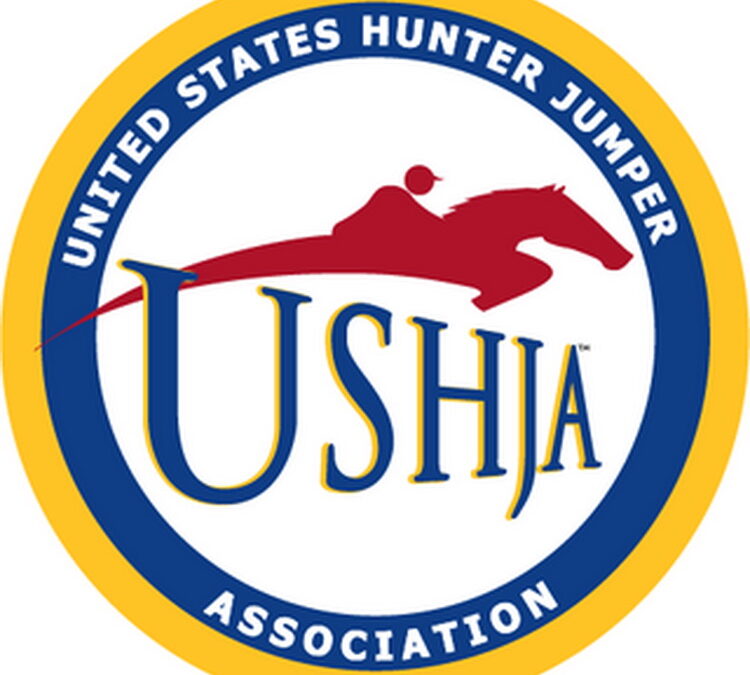
A new president takes over ahead of schedule at USHJA: Updated
Mary Knowlton, president of the U.S. Hunter Jumper Association since 2016, resigned after an investigation and has been succeeded by Britt McCormick, who was president-elect.
The issue involved building a new, independent information technology system for the Lexington, Ky.-based organization and the matter of oversight on the project.
Knowlton explained, “I was the subject of a whistleblower complaint, which is fine, and I was investigated. After the report came out, I was not afforded the chance to answer questions or speak in my own defense,” she continued, adding, “I find that to be dreadful, cruel and unAmerican.”
She noted that perhaps the USHJA board would have felt the same about her and others mentioned by the whistleblower if they were able to speak to the panel “but we weren’t offered that chance.”
McCormick, who was elected last December but wasn’t scheduled to take office until this December, said the “extensive” examination was undertaken by independent investigators.
The Texan, who took over after Knowlton’s Friday resignation, addressed her contention that she wasn’t given the opportunity to speak to the board in her defense. He explained, “She was interviewed by the independent investigators and made many statements and the board received those statements. I’ll just leave it at that.”
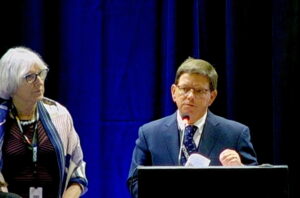
Mary Knowlton and Britt McCormick in 2023.
Noting the project will continue, he commented, “We’re spending members’ money, so we have to be very diligent in how we do that. I’ll be involved in informing the board of every step along the way, every expenditure that we make, any changes to the project. All of that will be brought to the board’s attention in a timely manner.”
In an email she sent to fellow volunteers on Tuesday, Knowlton said the board had given her only two choices; to resign or face “forcible removal.”
She said she chose resignation because she wanted to leave with dignity and that route aligned with the core values she strives to uphold in her personal and professional life. In the email, she emphasized to its recipients, “I remain open to being a resource if you need me.”
Kevin Price, who served as executive director under Knowlton, will continue in that role, McCormick said.
“Kevin has been instrumental in this transition. I will say kudos to the entire USHJA staff because they have been amazing.”
While it’s a time of change in the organization marking its twentieth anniversary, USHJA Vice President David Distler said, “I have faith in Britt. I think Britt’s going to do a great job.”
Asked about goals he wants to pursue immediately, the new president said, “The number one thing is repairing our relationship with the membership and repairing the relationship with the Federation (U.S. Equestrian Federation) and working to become the absolute best affiliate we can be.”
He believes “we lost the faith of some of the membership and we for sure needed a better relationship with the Federation.” USHJA is the largest USEF affiliate organization.
He also mentioned working on sport growth “not only at the introductory levels, but really looking to grow the sport at the elite and upper levels as well. We’re growing by leaps and bounds since Covid and we just need to take a fresh look at what our products are and who our customers are and get feedback from our stakeholders and make sure we’re on the right path.”
McCormick encourages people to get involved, “and make their voice heard, whatever that looks like for them. We would like new, fresh faces and people from all over the country at every level and every interest level. Everybody that jumps a horse, we welcome you in.
The president noted he is an active trainer and competitor “so I’m actually in the field. I think that sets me apart from a lot of people.”
McCormick commented, “I wish Mary nothing but the best and hope she stays a part of our community,” saying, “It’s up to her, her level of involvement.”
He mentioned she’s currently a member of the nominating committee and serves on a couple of other committees.
One thing he would like to change is the yearlong lag between election of a new president and the time that person assumes office. He wants to go back to the old system of a September election and having the winner take over in December.
Mud: Whatcha gonna do? Cornell knows
Steve Kraus, head of Farrier Services at the Cornell University Hospital for Animals, and Ken Estes, Ag Program leader for Cornell Cooperative Extension Livingston County, on April 16 will discuss mud management techniques for horse farms, including the effects of mud on horses’ feet and health and how to keep your equine facilities clean and safe.
The Zoom lecture is from 6-7 p.m. Registration is required, but it’s free. Go to this link.
This seminar will offer insight into specific horse health problems associated with muddy footing, as well as measures to take on your own horse farm to prevent mud and keep your equine facilities clean and safe.
Steve, a certified journeyman farrier, has served as the Cornell University Hospital for Animals’ Head of Farrier Services since 2010. A lifelong equestrian and polo player, Steve began shoeing horses in 1964, graduated with a degree in Animal Science from the Cornell University College of Agriculture and Life Sciences in 1971, and has had a distinguished career since then. In 2016, he was inducted into the International Farriers Hall of Fame.
Ken is an expert in natural resources and environmental conservation who also operates a Lippitt Morgan horse farm. His passion for environmental sustainability and the equine industry are combined through his work and his commitment to improving the welfare of horses, while fostering a more environmentally conscious approach to horse management.
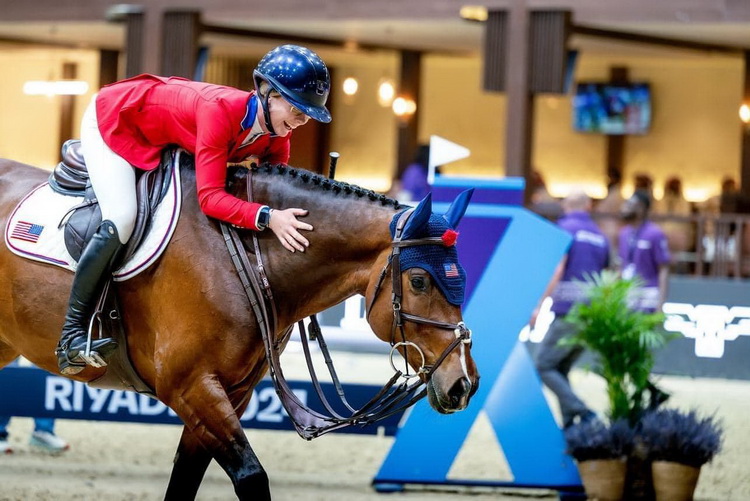
Skylar Wireman withdraws from SJ World Cup Final

Skylar Wireman and Tornado. (Helen Cruden photo)
Betty Durling has passed away
Services for Betty Correll Durling will be held at 11 a.m. April 20 at the Lamington Presbyterian Church in Bedminster, N.J.
Mrs. Durling, 94 died April 12 at her home in Whitehouse. She and her late husband, Carlton Durling were members of the Essex Fox Hounds for 40 years.
A resident of Vero Beach during the winters, she was a graduate of Kent Place School in Summit and Penn Hall College in Chambersburg, Pa.
An avid golfer, Mrs. Durling was a member of the Baltusrol Golf Club in Springfield. Prior to that, she belonged to the Roxiticus Golf Club in Mendham. Her name appears on many of the trophies at both clubs. She was also a member of the Women’s Metropolitan Golf Association and the Women’s New Jersey Golf Associations.
Mrs. Durling also was interested in bridge, and played her last game March 14.
She was a volunteer for several community services, including the Red Cross and Hunterdon Medical Center, and was instrumental in starting the Hunterdon County Office of Aging.
She is survived by two sons, C. Correll Durling of Hobe Sound, Fla., and Dean C. Durling of Whitehouse, a former master of the Essex Fox Hounds; her daughter, Denise T. Durling of Charlotte, Vt., nine grandchildren, and eight great-grandchildren.
Donations in her memory may be made to the Lamington Presbyterian Church, 355 Lamington Rd., Bedminster N.J. 07921
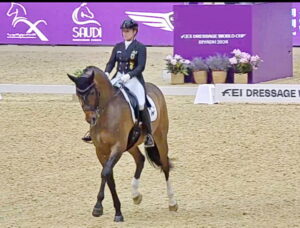
World Cup Dressage Finals under way; U.S. rider makes the top 10
Wednesday’s Grand Prix at the FEI World Cup Dressage Finals in Riyadh, Saudi Arabia, offered a taste of what is to come in the Freestyle, the only competition that counts for the title, but it does offer some insights.
In her twenty-fifth Finals, Germany’s Isabell Werth had uncharacteristic mistakes with DSP Quantaz, who had trouble in the two-tempi changes and fell out in the canter between the two pirouettes. That left her fourth on 72.236 percent. She likely won’t make the same mistakes on Friday during her ride to music.

Isabell Werth and Quantaz.
But it all went well for world champion Lottie Fry of Britain on Everdale (75.388), who took the lead. Everdale, the son of her world championships mount Glamourdale, showed off his usual ground-covering gaits.
She had a nice little margin over Sweden’s Patrik Kittel with Touchdown (73.292). He’s ahead of Danish rider Nanna Skodborg Merrald on Blue Hors Don Olymbrio (72.904).
The highest-placed of the three U.S. riders competing was Kevin Kohmann on Duenensee, tenth with 69.332. Anna Marek finished thirteenth with Fayvel (68.354) and Benjamin Ebeling stands next-to-last, 16th on Indeed (65.14).
All 17 riders will start in the Freestyle.
Patrik said he was “a bit surprised” about “Queen Isabell,” noting she normally goes in and does a great job.

Charlotte Fry won the World Cup Grand Prix with Everdale.
“That’s sport, that’s how it is. I’m sure she’s going to fight for it on Friday .but so of course will I, and Charlotte and everyone else,” he noted, adding it has been “amazing sport” and a “super show.”
This is the first time a finals has been held in the Middle East.
Click here for results.

